Constitution Hill
Johannesburg
Explore the REAL Johannesburg
” Start with a trip back in history to the darkest days of apartheid and end with a visit to the Constitutional Court – and the future’s promise of hope! “
” A provocative tour that exposes one to the treatment endured by both criminal and political inmates during the apartheid era. “
” An amazing guided experience – the court is free, but having a guide makes it come alive! “
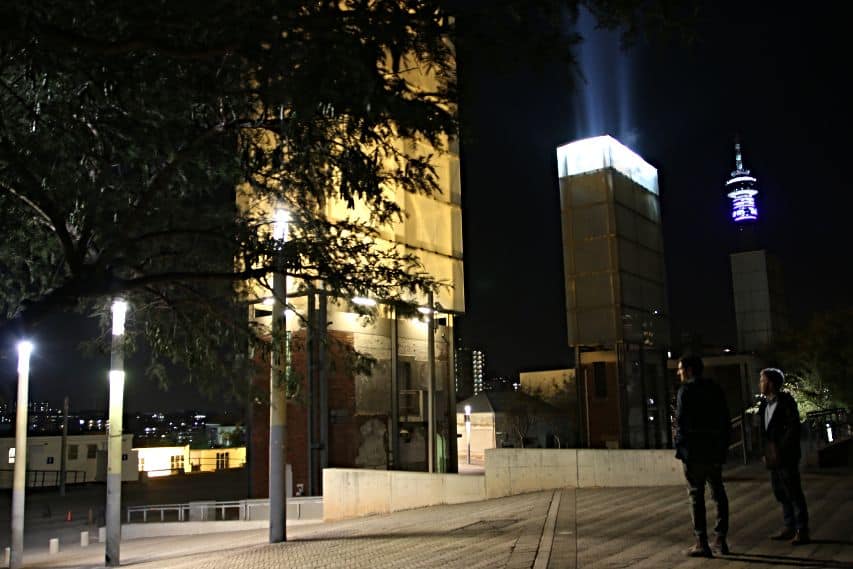
CONSTITUTION HILL
Johannesburg’s Constitution Hill is the Johannesburg equivalent of Cape Town’s Robben Island – only better, and is arguably the most interesting – and disturbing, historical precinct in the city.
The site has three prison museums :
– Johannesburg Fort and the old prison
– The Women’s Gaol
– Number Four Prison . . .
. . . as well as the remains of the Awaiting Trial Block.
The buildings have been left in their original condition, and nothing has been renovated, painted or paved – as ALL heritage buildings should be!
Amidst the gloom of incarceration, this is also the site of the highest court in the land – the Constitutional Court, which is open for visits – even when in session.
– oOo –
When the high security prison was built on the Braamfontein ridge in 1892, it overlooked and dominated the newly established gold mining settlement to the south.
At the time, Johannesburg was no more than a dusty, noisy mining camp.
The prison was built to lock up white male trouble makers in the burgeoning town below!
The Fort was added 7 years later, after the foiled – and failed, Jameson Raid, with the hope of protecting Johannesburg from British forces, during the looming Second Anglo Boer War.
The Number Four prison, opened in 1904, was built to house sentenced non-white male prisoners, and the Women’s Gaol, which opened in 1910, was built to house sentenced white and non-white female prisoners.
The Awaiting Trial Block was built in 1928 to house black men waiting for their day in court, but except for the remaining stairwells, was sadly demolished to make way for the Constitutional Court,
The precinct gets its name from the most recent addition to the historical site – the Constitutional Court, which opened in 2004.
Several famous political activists, who were imprisoned with hardened criminals, spent many cold nights in the dreadful conditions whilst imprisoned here.
Amongst them were Mahatma Gandhi, Nelson Mandela, Robert Sobukwe, Albert Luthuli, Joe Slovo and Winnie Mandela.
The museums now expose the inhumane treatment – and conditions, that inmates – especially black, had to endure during its more than 80 years in operation,
When opened in 1904, Number Four Prison was planned to house less than 1,000 inmates, but by 1983 that number had increased to over 2200, and the prison was closed due to overcrowding.
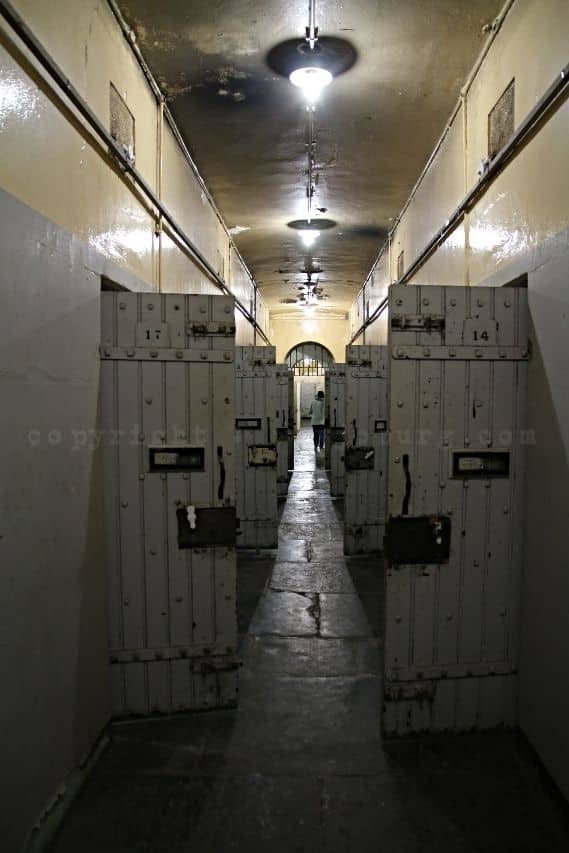
INFORMATION CORRECT
August 2024
CONSTITUTION HILL IS WHEELCHAIR FRIENDLY
CONSTITUTION HILL DOES NOT ACCEPT CASH
CONSTITUTION HILL OPENING TIMES :
Daily : 09h00 – 17h00 (9.00am – 5.00pm)
Last entry at 16h00 (4.00pm)
Close at 13h00 (1.00pm) : 24th December 2024
CLOSED : 25th and 26th December 2024
Close at 13h00 (1.00pm) : 31st December 2024
CLOSED : 1st January 2025
CONSTITUTIONAL COURT : ENTRANCE IS FREE
CONSTITUTION HILL ENTRANCE FEES :
Entrance and Self–Guided : NO Tour Guide
Adults : R100
Children (5-17 years) : R50
Pensioners and Students : R65
1 Hour Highlights Guided Tour
Daily, every hour, from 9am – 4pm.
Adults : R120
Children (5-17 years) : R55
Pensioners and Students : R80
2 Hours Full Guided Tour
Twice Daily, 10am and 1pm
Adults : R180
Children (5-17 years) : R100
Pensioners and Students : R100
For a number of other tour options, see the link to the Constitution Hill website, below
Tickets can be bought online via www.webticket.co.za or on site at the ticket office
CONSTITUTION HILL ADDRESS :
11 Kotze Street,
Braamfontein
Johannesburg
CONSTITUTION HILL GPS Co-ordinates (hddd.ddddd)
S26.190186° E028.043071°
CONSTITUTION HILL CONTACT :
Landline : +27 (0)11 381-3100
Send an E-mail : info@constitutionhill.org.za
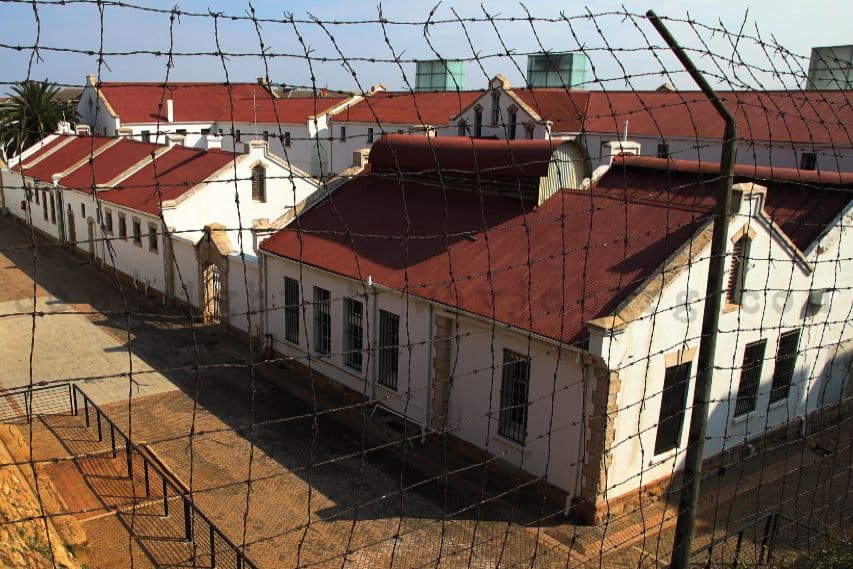
The Old Fort and Original Jail
Gold was discovered in 1886, in what was to become Johannesburg, in the conservative Calvinistic Zuid-Afrikaansche Republiek (ZAR), an independent Dutch speaking sovereign state, also known as the Transvaal Republic.
The ZAR was formed when Dutch-speaking colonists left the Cape Colony between 1835 and 1854 as Voortrekkers in the Great Trek, to escape British rule and seek their own Utopia.
The formation of their own independent republic in 1852 (ZAR), was that Utopia!
The discovery of gold created a gold rush, but much to the dismay of the President of the South African Republic (ZAR), Paul Kruger, flocks of “Uitlanders” (‘foreigners’ or ‘outsiders’) poured into his puritanical Dutch Republic to seek their riches.
Living conditions for these fortune seekers on the inhospitable and treeless, dusty veld, were harsh, and crime was rife.
To quell this unacceptable, permissive behaviour, Kruger built the prison on the crest of today’s Constitutional Hill.
The strategic position allowed the Boers to not only watch over, and intimidate, the “Uitlanders” in the burgeoning town below, but also make the wrong-doers aware of what was waiting for them!
Fast forward to December 1896, when an attempt was made by the British colonial administrator Leander Starr Jameson, under the service of Cecil John Rhodes, to spark an uprising by the mainly British “Uitlanders” and overthrow the ZAR of Paul Kruger.
The raid, which took place between 29th December 1895 and 2nd January 1896, was a failure, and a huge embarrassment to British government.
The raid was a contributing factor to the Second Anglo Boer War, and alerted Paul Kruger to the intentions of the British Government.
Building of the Johannesburg Fort and its earthen ramparts, on ground surrounding the prison, began in 1896, and was completed in 1899 – before the October start of the Second Anglo Boer War.
No shot was fired from the Fort before Johannesburg surrendered, and fell to the advancing British troops on 31st May 1900.
The fort and the prison fell under British control, and the former Boer fort and prison was then used to confine Boer soldiers.
Having lost a traditional war, the Boers then turned to guerilla warfare, which resulted in a bloody war until they once again surrendered to British forces, this time on 31st May 1902.
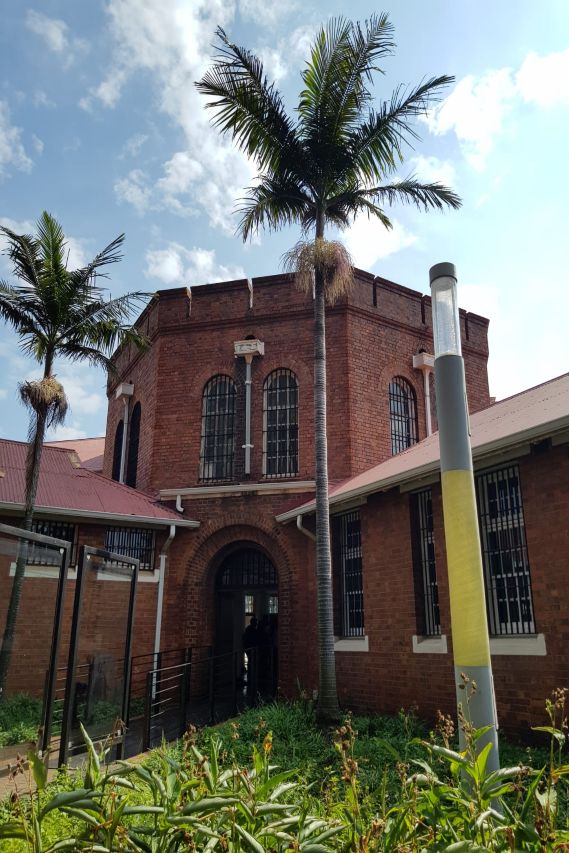
The Women’s Gaol
The beauty of the Women’s Gaol building somewhat disguises the humiliation female prisoners had to endure behind bolted doors.
The design is loosely based on a Panopticon prison design, with a beautifully proportioned central atrium and corridors with cells radiating out from there.
The prison was built in 1910 to incarcerate both black and white female inmates, although racial segregation, and later apartheid, ensured they were kept separate from one another.
The inmates were both common criminals – the best known was Daisy de Melker, a murderer who was hanged in 1932 – and political prisoners.
Far more black women than white women were incarcerated as they were involved in petty apartheid crimes, such as brewing beer illegally, as well as contravening pass laws.
Their imprisonment had an irrevocable effect on their families.
White women were not affected by these apartheid laws.
A part of the Women’s Gaol building was occupied by the South African Civil Cooperation Bureau (CCB), between 1983, when the prison closed, and 2002.
The CCB, was a government-sponsored death squad unit during the apartheid era that operated in secret.
It was responsible for a number of significant political assassinations, including those of Dr. David Webster and Ben Langa.
Renovations were sadly made during this time that angered a number of former inmates, as the changes hid some of the horrors that they had to endure.
They feel we now see a more sanitised building that does not fully expose the past.
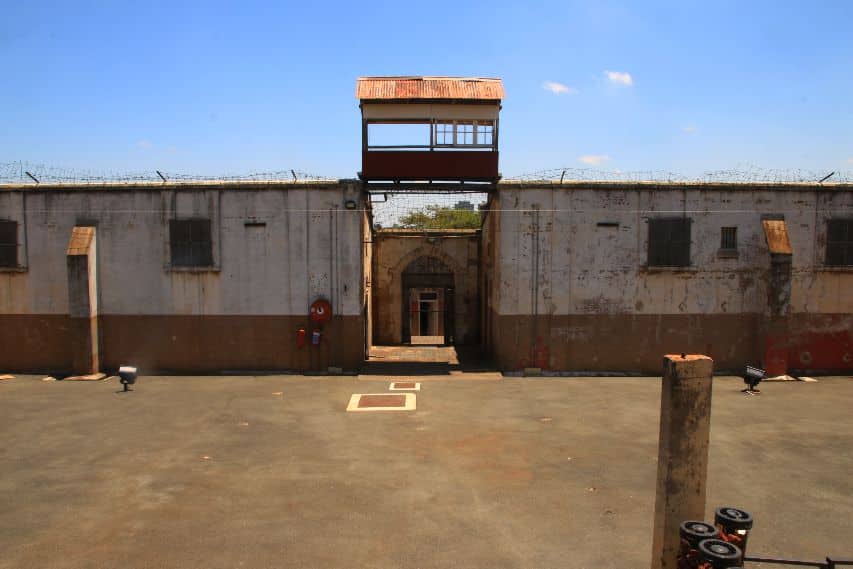
The Number Four Prison
You enter the desolate and austere Number Four prison from the ticket office and are immediately confronted with a quote from Nelson Mandela that gives you a taste of what’s ahead!
“It is said that no one truly knows a nation until one has been inside its jails. A nation should not be judged by how it treats its highest citizens, but its lowest ones – and South Africa treated its imprisoned African citizens like animals.”
In 1902, whilst the prison in the Fort interned white prisoners, new sections were built, known as Numbers Four – to house short term, and Number Five – to house long term black prisoners.
These new buildings, which opened in 1904, consisted of large communal cells designed to house close on a thousand inmates, but later became overcrowded, filthy and rife with disease.
Number Four was infamous, not only for the cruel treatment of its inmates, but also for its gangs – which originated here, and still exist in South Africa’s prison system today!
These gangs were complicated and pervasive and their abuse, harassment and intimidation was only one feature of a life already made almost intolerable by prison authorities who subjected inmates to frequent and excessive humiliation.
Food which was served close to the open toilets, was rationed according to your race group and African men received the smallest and least nutritious portion.
TAUSA ‘DANCE’
When prisoners, sentenced to hard labour, returned from outside, they were strip searched in the courtyard by the warders during a humiliating ‘dance’ known as the Tausa!
Naked prisoners were made to leap into the air, spin around and open their legs, whilst clapping their hands above their head.
When landing they’d make a clicking sound with their mouth and bend their body forward in such a way that prison warders could inspect their anuses for smuggled contraband.
The late Bob Gosani, a young Drum magazine photographer at the time, secretly took a series of photographs from the top floor of a nurses’ home overlooking the prison courtyard of inmates performing Tauza.
This led to a public outcry when the photos were published.
ISOLATION CELLS
A row of tiny isolation cells metered out the harshest punishment to inmates who were kept in solitary confinement for 23 hours a day – sometimes for more than a year, and fed a diet of rice water.
Two buckets were provided – one with water and the other a toilet!
Former political prisoners incarcerated in Number Four include Mahatma Gandhi, Robert Sobukwe and Albert Luthuli.
The prison closed in 1983 due to overcrowding, and the inmates moved to a newly built prison that was given the nickname “Sun City” – after the hotel resort, because of its comparative luxury!
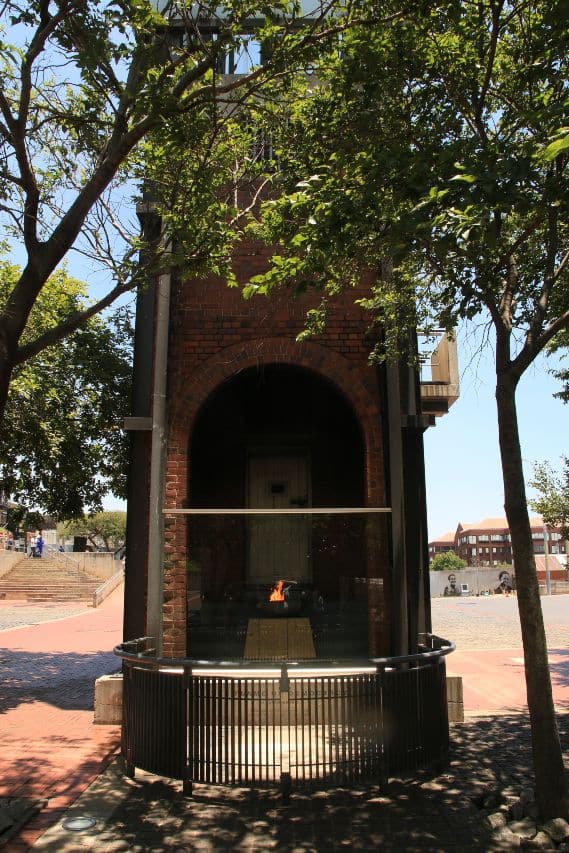
Awaiting Trial Block
Notable figures like Nelson Mandela, Albert Luthuli (President-General of the ANC), and Mahatma Gandhi were held here.
The Awaiting Trial Block was a massive multi-story building constructed in 1928, where black “prisoners” were held while waiting to stand trial.
Most of the building was demolished in 2001 to make way for the Constitutional Court, but four stairwells were preserved.
Two stairwells remain in the public square, one is part of the Constitutional Court’s foyer, and the fourth is behind the Court.
The bricks from the original building were used in the construction of the Court and the Great African Steps.
The human figures on the paving represent the shadows of prisoners waiting for their trials—short in the morning light and long at the end of the day.
The Flame of Democracy, housed in one of the stairwells, was lit on December 10, 2001, to celebrate the 15th anniversary of the signing of the Constitution.
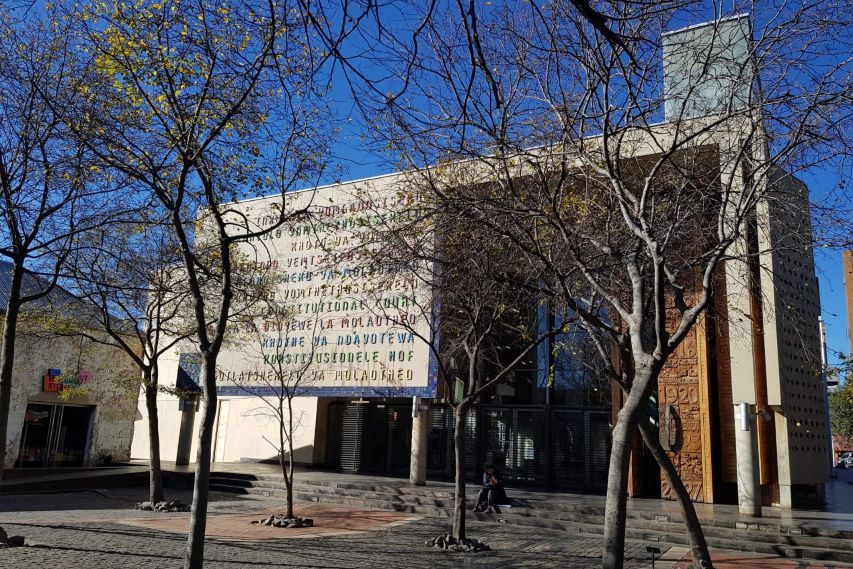
The Constitutional Court
The Constitutional Court is the highest court in the land, but only deals with constitutional issues arising from the country’s first democratic Constitution in 1994.
The site was chosen by judges, mainly for its historical and symbolic importance.
It highlights the relationship between a dark past, and a possible bright future.
A group of young South African architects – representing OMM Design Workshop in collaboration with Urban Solutions, won a major international competition to design and build the new Constitutional Court.
Their theme of the design is “African Justice under a Tree”
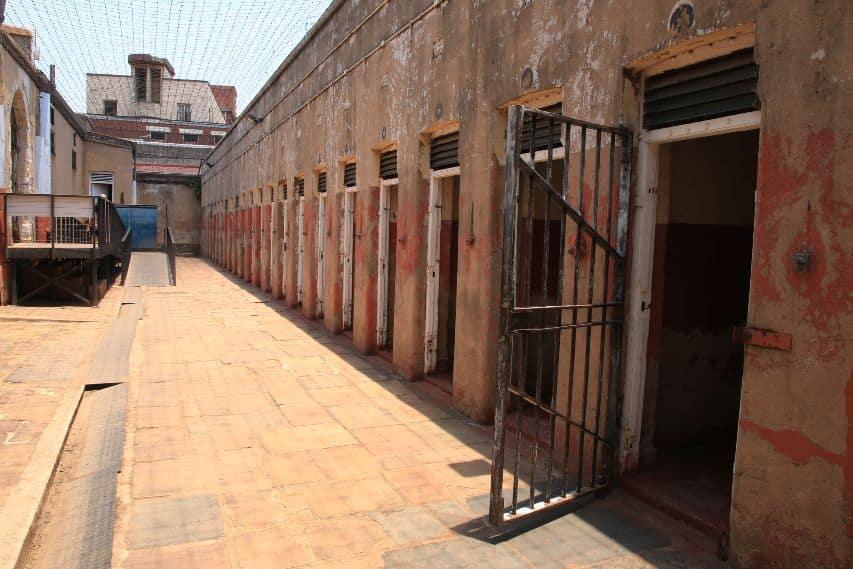

Recent Comments